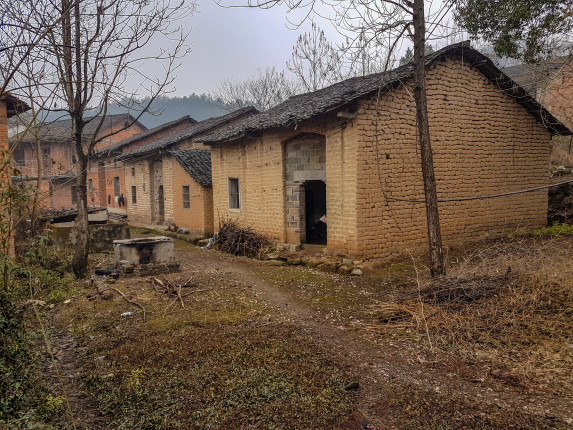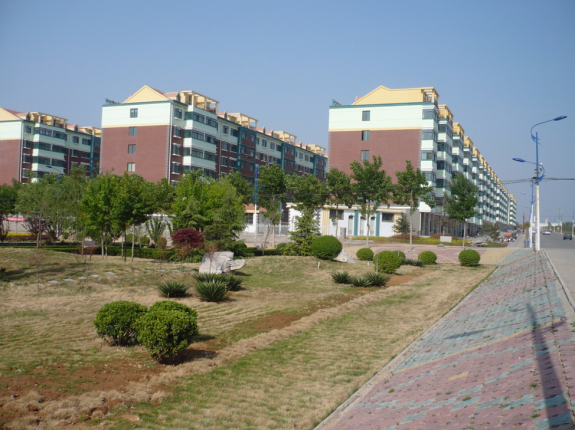-
China’s Hollow Villages Undergo a Transformation
April 4, 2019 By Karen Mancl
As an agricultural engineering professor, I was excited to visit and tour the farm village Houbali, in southwestern Shandong Province. I found myself standing among newly constructed high-rise buildings, a vastly different community than I had expected to encounter. A bicycle repair shop was setting up alongside other bustling businesses in the first-floor storefronts. Farm families occupied apartments in the upper floors and a beautifully landscaped park and playground were a short walk away. This neighborhood looked like a transplant from Beijing, but these modern buildings were a newly developed farm village surrounded by agricultural fields. The new buildings brought together the residents of four old, nearly empty or “hollow” villages.
Hollowed Out Rural Villages
Hollow villages are the result of sprawl in the countryside. The Chinese Academy of Sciences Institute of Geographic Sciences and Natural Resources Research surveyed residents and government officials in 43 villages to learn more about their attitudes toward new rural development, and the results reveal why villages are sprawling. Residents were leaving their old and uncomfortable adobe or brick homes and building new homes on the village fringe.
Some homes are now vacant as younger adults moved to the city to find higher paying jobs, leaving behind the old and the children. Many Chinese village populations have decreased from 1,000 to 2,000 residents down to a few hundred. As a result of both new construction and loss of residents, these old, “hollow villages” had a lot of unused land.
Building New Villages
I was mystified. How could a rural community afford such an extensive housing development project? Local officials told me they financed the new construction by selling the land development rights of several nearby hollow villages to a city in eastern Shandong Province. This was not a shady land deal, but rather the result of the stringent policy, Dynamic Balance of Total Farmland Area, that makes it illegal to convert high-quality cultivated land to non-agricultural use. The policy aims to protect food security and stop farmland loss. Between 2001 and 2013, China’s rapid urbanization consumed 33 million hectares of agricultural land (about three Mississippis). Parallel farmland loss trends are seen in the United States as well. The United States lost 12.5 million hectares of farmland (the size of Mississippi) to development around small towns and big cities between 1992 and 2013.
Under the Dynamic Balance policy, any Chinese city wishing to build on existing farmland must compensate that loss with new farmland of equal or greater area. Since cities have little undeveloped land to convert to farms, municipal governments can pay rural villages in other parts of the same province to reclaim farmland. This enables villages, like Houbali, to be paid to reclaim the land from now hollowed out villages, so a city can move ahead with expansion. This program is the largest investment in rural development since the founding of the Peoples Republic of China.
This transfer of development rights from a village to a city generates the money needed to revitalize rural China and construct new, more consolidated villages. The farmers benefit in many ways from this exchange of development rights from new homes or apartments with public utilities, all while retaining the restored farmland and the right to farm it. These land consolidations renovated 13.3 million ha of land and added 2.8 million ha of new farmland between 2001 and 2010 — equivalent to the State of California. The value of the reclaimed farmland averaged 690,000 RMB per ha ($102,000 per ha) in 2007 and has been increasing each year.
For example, the new village of Keyu was constructed to bring together the 1,948 residents from 4 hollow villages in Shandong Province restoring 125 hectares (309 acres) of land to agriculture. For this effort a large, east coast city government paid $20 million to the new village. The money was used to build the new, more compact community and reclaim the unused land from the old villages back for agriculture.

Selling Development Rights
When rural governments sell the development rights from the wasted village land to cities, the land transactions rely on the entrepreneurial abilities of local officials. Land conversion was occurring so rapidly in China that it exceeded the central government’s capacity to control the conversions. To close the gap in supervision, provincial governments had to establish an inspection program to verify the quality of the reclaimed farmland.
To better manage the development rights transfer, Chongqing was the first to adopt a “land ticket” system. Farming must first start on the reclaimed agricultural land. Provincial officials then inspect and measure the land and issues land tickets, which are sold to cities needing reclaimed land at a public auction. The new land ticket owner selects farmland to be developed, then requests a transfer of land use rights from provincial officials. This streamlined approach takes the local city and village officials out of the transaction negotiations in an attempt to increase equity and efficiency in land conversions.
New Village Design
Since my first trip to Houbali, I have visited many new villages that have benefitted from selling development rights. Not all have high-rise apartments. Some have adopted more traditional farmhouse and ethnic looks. Lejia, in western Shandong Province, constructed traditional looking two-story homes with walled courtyards to hide the cars, allowing the community to retain its traditional appearance. All Lejia village homes have electricity and running water; the village even has a new wastewater treatment system. On the reclaimed farmland, nut trees are grown and harvested.

Winning or Losing
The goal of the Dynamic Balance of Total Farmland Area policy is to maintain farmland and provide food security in the face of rising development pressure. The results have been mixed. Use of converted land to grow crops has been lower than expected with only about 37 percent of the reclaimed land under cultivation largely due to poor soil quality and serious soil compaction in the hollow villages. More attention and oversight will be needed to ensure land is completely reclaimed to productive agricultural land.
Also, the land conversion program cannot last forever. As the ability to sell development rights is shrinking in the more developed eastern provinces, China is starting to open up trading nationwide. With an inter-provincial trading scheme, financial support will flow from cities in the rich eastern provinces to poor western rural areas.
The Dynamic Balance of Total Farmland Area program sets up the potential for win-win-win solutions. Cities win as they can buy development rights to allow for more industrial, business and housing construction. Rural villages win by selling development rights for their wasted land to gain the financial resources to build new housing and infrastructure while increasing their farmland area. Finally, the central government wins by controlling sprawl and stabilizing China’s farmland area. The approach serves as a model for other countries that want to set up a system that allows both urban and rural areas to benefit from economic development while still ensuring food security, funding rural development, discouraging sprawl and protecting farmland for the future.
Karen Mancl is a Professor of Food, Agricultural and Biological Engineering at The Ohio State University. In 2019, she is working as a research assistant in the Woodrow Wilson China Environment Forum. She specializes in rural wastewater treatment and has developed low-cost treatment systems installed in Ohio and China. Her PhD in Water Resources is from Iowa State University and MA in East Asian Studies from Ohio State University.
Sources: China.org.cn, China Geographical Science, Chinapedia, Habitat International, Investigate Midwest, CARD, Land Use Policy, URBACHINA, Sustainability, Industry.people.com.cn
Top photo caption: Empty homes in a Chinese hollow village. Source: Shutterstock. All rights reserved.
Middle photo caption: These buildings at a new farm village, Houbali, in Shandong Province, house residents who abandoned four hollow villages. Photo courtesy of the author.
Bottom photo caption: In Lejia, a new village of traditional looking farmhouses in Shandong Province, each home is served by public utilities. Photo courtesy of the author.
 A Publication of the Stimson Center.
A Publication of the Stimson Center.








